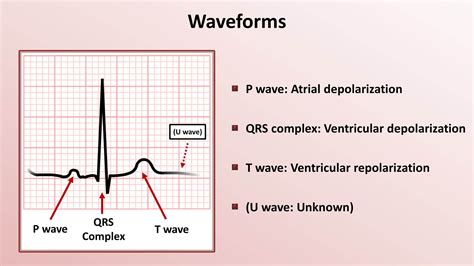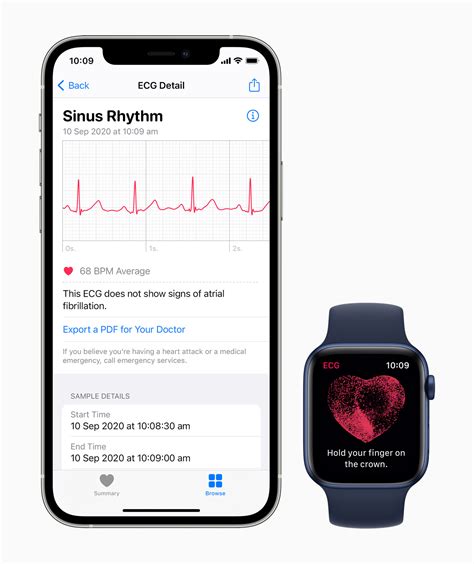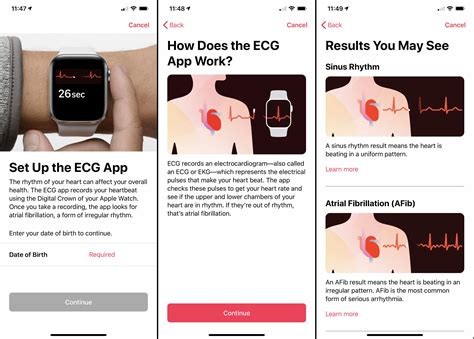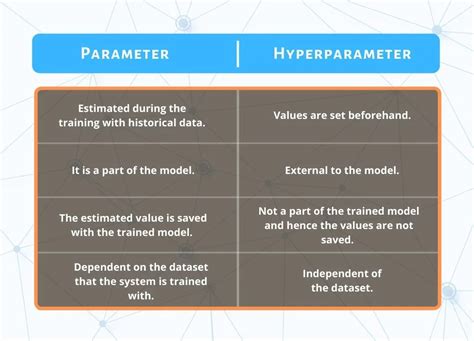In the realm of wearable technology, the integration of electrocardiogram or ECG functionality has revolutionized how we monitor our cardiovascular health. The advent of the Apple Watch 7 introduces a whole new dimension to our understanding and management of heart rhythms, allowing us to tap into a wealth of data and insights that were previously inaccessible.
Imagine having a device on your wrist that can decode the intricate electrical signals pulsating through your heart, providing you with a snapshot of its activity and alerting you to any irregularities or potential concerns. With the ECG feature on the Apple Watch 7, this futuristic-sounding concept becomes a reality, demystifying the inner workings of your heart and empowering you to take proactive measures towards your well-being.
What sets the ECG functionality on the Apple Watch 7 apart from traditional heart rate monitors is its ability to capture a detailed waveform of your heart's electrical activity, painting a comprehensive picture of its function. By measuring the electrical impulses and analyzing their patterns, this cutting-edge technology can detect irregular heart rhythms, such as atrial fibrillation (AFib), which often goes unnoticed but can potentially lead to serious health complications.
Understanding Electrocardiogram (ECG)

An electrocardiogram (ECG) is a medical test that provides valuable information about the electrical activity of the heart. It records the electrical signals produced by the heart as a series of waves, which can help healthcare professionals diagnose and monitor various heart conditions.
The ECG measures the heart's electrical impulses and translates them into a visual representation, allowing healthcare providers to assess the heart's rhythm, rate, and overall function. By analyzing the ECG waveform patterns, medical professionals can detect abnormalities, such as irregular heartbeats (arrhythmias), heart attacks, and other cardiovascular problems.
ECGs are usually performed using specialized equipment, but advances in technology have made it possible to incorporate this diagnostic tool into wearable devices like the Apple Watch 7. These devices utilize sensors placed on the skin to detect and measure the heart's electrical signals, providing users with convenient and continuous monitoring capabilities.
The availability of ECG monitoring on devices like the Apple Watch 7 allows individuals to gain insights into their heart health and potentially identify any irregularities that may require further medical attention. It's important to note, however, that an ECG obtained from a smartwatch or wearable device should not replace a medical-grade ECG performed by a qualified healthcare professional.
In summary, an electrocardiogram (ECG) is a diagnostic tool that records the heart's electrical activity, providing valuable information for diagnosing and monitoring various heart conditions. Wearable devices like the Apple Watch 7 offer the convenience of ECG monitoring, potentially allowing users to detect irregularities in their heart's rhythm and seek appropriate medical care.
Importance of ECG in monitoring heart health
The significance of electrocardiogram (ECG) cannot be overstated in the realm of heart health monitoring. This non-invasive diagnostic test plays a crucial role in detecting and analyzing the electrical activity of the heart, enabling healthcare professionals to identify potential irregularities or abnormalities.
Monitoring Heart Rhythm: ECG serves as a valuable tool in monitoring the rhythm of the heart. By measuring the electrical signals produced by the heart's chambers, an ECG can provide vital insights into the heart's overall functioning, including the pace and regularity of its beats. This information is essential for detecting conditions such as arrhythmias, where the heart beats too fast, too slow, or irregularly.
Detecting Cardiac Disorders: ECG helps in the early detection of various cardiac disorders, including myocardial infarction, commonly known as a heart attack. By analyzing the electrical patterns on the ECG graph, healthcare professionals can identify specific abnormalities indicative of compromised blood flow to the heart, thus allowing for prompt intervention and potentially life-saving treatment.
Assessing Heart Rate Variability: Heart rate variability (HRV) refers to the variation in the time interval between heartbeats. ECG can accurately measure and analyze HRV, providing valuable information about the autonomic nervous system's balance and the heart's adaptability to different situations. HRV analysis can aid in assessing the body's stress levels, overall well-being, and the risk of developing cardiovascular diseases.
Assisting in Treatment Decisions: The data collected from ECG examinations can aid healthcare professionals in making informed treatment decisions. By analyzing the ECG results, medical experts can determine the effectiveness of prescribed medications, evaluate the need for further diagnostic tests or interventions, and track the progress of patients with cardiac conditions over time.
Enhancing Early Warning Systems: The integration of ECG technology into wearable devices, such as the Apple Watch 7, has revolutionized heart health monitoring. With the convenience of having ECG capabilities readily available on the wrist, individuals can promptly capture and share their ECG readings with healthcare professionals, enabling early detection and intervention in case of any concerning cardiac symptoms.
Empowering Individuals: ECG, when accessible and understandable, empowers individuals to take an active role in managing their heart health. By familiarizing themselves with their ECG readings and understanding the significance of key indicators, individuals can make informed lifestyle choices, seek medical attention when necessary, and potentially prevent or minimize the impact of heart-related conditions.
Overall, the integration of ECG technology, such as that found in the Apple Watch 7, provides an excellent opportunity for proactive heart health monitoring, enabling timely detection of potential issues, and ultimately leading to improved overall cardiovascular well-being.
Overview of the ECG feature on Apple Watch 7

In this section, we will explore an introduction to the functioning of the Electrocardiogram (ECG) feature available on the latest Apple Watch 7. The ECG feature provides users with a convenient and portable way to monitor their heart health and detect potential irregularities or abnormalities. By analyzing the electrical signals produced by the heart, the Apple Watch 7 can provide valuable insights into the user's overall cardiovascular well-being.
Electrodes and sensors used in the ECG feature of Apple Watch 7
In order to measure the electrical activity of the heart, Apple Watch 7 utilizes a sophisticated system of electrodes and sensors. These components, strategically placed on the device, work together to capture and analyze the user's heart rhythm, providing valuable health insights.
| Component | Function |
|---|---|
| Ambient Light Sensor | Measures the intensity of light, ensuring accurate readings by adjusting the display brightness to optimize electrode function. |
| Electrodes | Act as conductive contacts to make direct contact with the skin, detecting the minute electrical signals emitted by the heart. |
| Photodiode Sensors | Work in collaboration with the electrodes to detect changes in blood flow, enhancing the accuracy of heart rate and rhythm measurements. |
| Infrared and Green LEDs | Deliver specific wavelengths of light to the skin, allowing the photodiode sensors to accurately measure blood flow levels. |
| Electrocardiogram (ECG) App | Utilizes the data collected from the electrodes and sensors to generate a detailed ECG waveform, providing users with critical information about their heart health. |
By combining these advanced components, the ECG feature on Apple Watch 7 offers users a convenient and non-invasive way to monitor their heart activity and detect potential irregularities. The accurate readings obtained through the electrodes and sensors, coupled with the powerful processing capabilities of the device and its dedicated ECG app, empower users to take a proactive approach towards their cardiac well-being.
Process of taking an ECG using Apple Watch 7

The Apple Watch 7 incorporates a revolutionary feature that allows users to perform an electrocardiogram (ECG) directly from their wrist. This innovative technology utilizes advanced sensors and algorithms to accurately capture and analyze electrical signals generated by the user's heart. Through a simple non-invasive process, the Apple Watch 7 empowers individuals to gain insights into their heart health, detect potential irregularities, and share important data with healthcare professionals.
To initiate the ECG recording, the user must firmly press their finger against the digital crown located on the side of the Apple Watch 7. This action completes a circuit, enabling the watch to detect and measure the electrical activity of the heart. The digital crown's electrodes, along with the sensors on the back crystal, work together to capture the subtle rhythms and waveforms produced by the heart's electrical system.
Once the ECG recording is in progress, the Apple Watch 7's display will showcase a stunning visualization of the heart's electrical activity in real time. Users can observe the waveforms moving across the screen, providing a visual representation of the heart's performance. The watch also measures the duration of the recording, ensuring that sufficient data is collected for accurate analysis.
After the ECG recording is complete, the Apple Watch 7 employs its advanced algorithms to analyze the captured data. The watch's powerful processor and software work in harmony to evaluate the heart's rhythm and identify any irregularities or abnormalities. If a potential cardiac condition is detected, the user will receive a notification on their watch, urging them to seek further medical advice.
Furthermore, the Apple Watch 7 allows users to save their ECG recordings as a PDF file, which can be easily accessed on their paired iPhone. This feature enables individuals to maintain a digital record of their heart's electrical activity over time, facilitating discussions with healthcare professionals during routine check-ups or in the event of any concerns.
In conclusion, the Apple Watch 7 revolutionizes the process of taking an ECG, giving users the ability to monitor their heart health conveniently and proactively. By leveraging cutting-edge technology and intelligent algorithms, this remarkable device empowers individuals to gain valuable insights, take control of their well-being, and ultimately enhance their overall quality of life.
Interpreting ECG Results on Apple Watch 7
Understanding the data provided by the ECG feature on the latest Apple Watch can be key for users in monitoring their heart health and detecting potential abnormalities. By analyzing the electrical signals generated by the heart, the ECG feature on the Apple Watch 7 provides valuable insights that can assist individuals in assessing their overall cardiovascular well-being.
Identification of possible cardiac conditions
One essential aspect of interpreting ECG results on the Apple Watch 7 is identifying potential cardiac conditions. By carefully examining the waveform patterns and intervals between peaks, users can gain insights into irregular heart rhythms such as atrial fibrillation or abnormal heart rates. These findings can prompt individuals to seek medical attention and enable healthcare professionals to make more informed diagnoses.
Assessing heart rate variability
In addition to detecting arrhythmias, the ECG feature on the Apple Watch 7 allows for an assessment of heart rate variability. By analyzing the variation in the time intervals between each heartbeat, users can gain insights into their autonomic nervous system's functioning. This information can be indicative of stress levels, recovery capabilities, and overall cardiovascular fitness.
Monitoring changes over time
Interpreting ECG results on the Apple Watch 7 also involves monitoring changes in patterns and trends over time. By comparing previous ECG recordings with current ones, users can observe any shifts or developments in their cardiac health. This long-term tracking can provide valuable information for both users and medical professionals in evaluating the effectiveness of treatments, identifying triggers, and making necessary adjustments in managing cardiovascular conditions.
Understanding measurement limitations
It is essential to acknowledge the limitations of ECG measurements on the Apple Watch 7. While the technology allows for convenient real-time monitoring, it is crucial to understand that the device's readings should not replace professional medical assessments. ECG results on the Apple Watch should be interpreted as indications that further examination may be warranted, guiding users to seek proper medical advice for accurate diagnosis and treatment.
By understanding how to interpret ECG results obtained from the Apple Watch 7, users can effectively utilize this feature to monitor their heart health, detect potential cardiac conditions, assess heart rate variability, and track changes over time. However, it is essential to bear in mind the device's limitations and seek professional medical attention for comprehensive evaluation and personalized care.
Understanding the different parameters and measurements

In this section, we will explore the various parameters and measurements involved in the functioning of the electrocardiogram (ECG) feature on the latest iteration of the Apple smartwatch.
The ECG feature on the Apple Watch 7 encompasses a range of essential measurements that provide insights into your heart's electrical activity and overall cardiovascular health. By analyzing these parameters, users can gain a deeper understanding of their heart health and potentially detect any abnormalities or irregularities.
One of the primary parameters measured by the ECG feature is the heart rate variability (HRV). HRV refers to the variation in the time interval between consecutive heartbeats and is considered an indicator of the autonomic nervous system's functioning. Monitoring HRV can help identify potential stress levels, fatigue, or cardiovascular conditions.
Another crucial measurement provided by the ECG feature is the detection of atrial fibrillation (AFib). AFib is a common heart arrhythmia that can significantly increase the risk of stroke. By capturing and analyzing the electrical signals produced by the heart, the Apple Watch 7 can detect potential signs of AFib and alert the user to seek medical attention.
Additionally, the ECG feature on the Apple Watch 7 also enables the measurement of the QT interval. The QT interval represents the time it takes for the ventricles to depolarize and repolarize during the cardiac cycle. Abnormal QT intervals can indicate a higher risk of certain conditions such as arrhythmias and potential sudden cardiac events.
Furthermore, the ECG feature measures the PR interval, which represents the time it takes for the electrical signal to travel from the atria to the ventricles. Changes in the PR interval can indicate underlying heart conditions or issues with the electrical conduction system.
By providing these different parameters and measurements, the ECG feature on the Apple Watch 7 empowers users to proactively monitor their heart health and potentially detect any abnormalities. It is important to note that the ECG feature is not intended for diagnosis but serves as a valuable tool for early detection and intervention.
Taking Action Based on ECG Results from the Latest Apple Smartwatch
Understanding and interpreting the ECG results from your Apple Watch 7 is just the beginning. To maximize the potential of this cutting-edge technology, it is crucial to take appropriate action based on the data provided. By utilizing the insights gained from your ECG readings, you can make informed decisions about your cardiovascular health and seek necessary medical attention if required.
Here are some key steps to consider when taking action based on ECG results:
- Consult with healthcare professionals: While ECG readings from your Apple Watch provide valuable information, it is essential to consult with healthcare professionals for a comprehensive analysis and accurate interpretation. Discuss your ECG results with your doctor or cardiologist for personalized guidance and advice.
- Maintain regular monitoring: Regularly monitor your ECG results using the Apple Watch 7 to track changes and identify any potential abnormalities or patterns. Keeping a record of your ECG readings over time can assist healthcare professionals in identifying trends that may require attention.
- Take proactive measures: If your ECG results indicate any irregularities or abnormalities, take proactive measures to support your cardiovascular health. This may include adopting a heart-healthy lifestyle, such as regular exercise, a balanced diet, and stress management techniques. Following your healthcare professional's guidance is crucial for preventive measures.
- Seek medical attention promptly: If the ECG results from your Apple Watch 7 suggest serious cardiac conditions or any significant changes, promptly seek medical attention. Contact your healthcare provider or seek emergency services if necessary. Early detection and intervention can be crucial in minimizing potential risks and promoting optimal heart health.
- Track symptoms and correlate with ECG results: Pay attention to any symptoms or changes in your overall well-being, as these can provide further context to your ECG results. Note down symptoms such as chest pain, palpitations, shortness of breath, or dizziness, and discuss them with your healthcare professional. Correlating symptoms with ECG findings can help guide the appropriate course of action.
The ECG feature on the Apple Watch 7 empowers users to monitor their heart health conveniently. However, it is important to remember that the Apple Watch 7 ECG is not a substitute for professional medical advice. By taking informed action based on the ECG results and working closely with healthcare professionals, you can optimize the benefits of this technology and prioritize your cardiovascular well-being.
FAQ
How does the ECG feature work on the Apple Watch 7?
The ECG (Electrocardiogram) feature on the Apple Watch 7 works by using sensors on the watch's back crystal and the Digital Crown to measure the electrical signals of your heartbeat.
Is the ECG feature on the Apple Watch 7 accurate?
Yes, the ECG feature on the Apple Watch 7 is considered to be highly accurate. It has been validated by several studies and has received clearance from regulatory authorities like the FDA in the United States.
Can I use the Apple Watch 7's ECG feature to detect heart arrhythmias?
Yes, the ECG feature on the Apple Watch 7 can help in detecting certain heart arrhythmias such as atrial fibrillation. If an irregular rhythm is detected, the watch will notify you and suggest consulting a healthcare professional for further evaluation.
Do I need to have my iPhone nearby to use the ECG feature on the Apple Watch 7?
No, you don't need to have your iPhone nearby to use the ECG feature on the Apple Watch 7. The watch has built-in ECG functionality, and the readings can be stored directly on the watch for later analysis or shared with your healthcare provider.
Are there any limitations to using the ECG feature on the Apple Watch 7?
Yes, there are a few limitations to keep in mind when using the ECG feature on the Apple Watch 7. It may not be able to detect all types of arrhythmias, and it is not intended for use by people under the age of 22. Additionally, it should not be relied upon as a substitute for professional medical advice.
How does ECG monitoring work on Apple Watch 7?
ECG monitoring on Apple Watch 7 works by utilizing built-in electrodes in the digital crown and the back crystal of the watch. When a user places their finger on the digital crown, it completes a circuit in the watch, allowing electrical signals to be measured and analyzed. These signals are then used to generate an electrocardiogram, which can provide valuable insights into the user's heart health.
What information can ECG on Apple Watch 7 provide?
The ECG feature on Apple Watch 7 can provide information about your heart's electrical activity, including detecting irregular rhythms such as atrial fibrillation (AFib). It can also analyze the rhythm to determine if it's within normal range or if there are any signs of arrhythmias. However, it's important to note that the ECG feature is not intended to diagnose any heart condition. Instead, it serves as a screening tool that can help users identify potential issues and seek further medical advice if necessary.




